Developing a sense of place is important to us at Whangamata Kindergarten. Children at our centre have been taught about mihi and we have helped each child to write their own. These are displayed on the kindergarten wall.
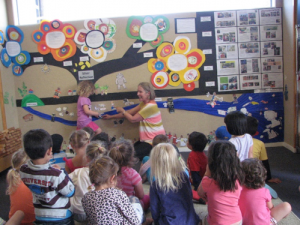
Children use the wall display to tell stories, recreate their experiences and consolidate learning.
We have talked to the children about special places, including our kindergarten, and showed them a map of our area. Some children decided to draw their own maps including places that were special to them. Teachers realised through these interactions that not many children knew about the maunga and awa close to the kindergarten. They had all been to the beach, but they didn’t know about the awa/ stream that flowed from the maunga/ mountain to the moana/ sea.
Staff booked the Kindergarten Association van, and took small groups of children on an excursion. Off they went up the maunga, down the maunga to the awa, along the awa to the moana! Each time they saw something, they used the local Māori names to talk to children about those places. Back at the centre, staff had made a huge wall display with the mountain, stream and sea.
Children were encouraged to draw themselves to fit into the picture. They drew the van, they drew the sky and the sun. They drew some birds and some trees.
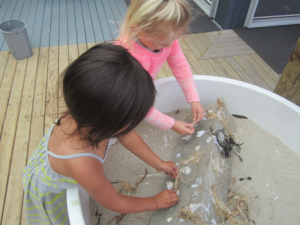
Children were guided through construction of a dotterel hide, applying sand and shells for camouflage.
Children now use the wall image to tell their stories about the trip up the maunga, down the maunga along the awa, out to the moana, and back to the centre. Stories change!
More things are added. The pepeha/ mihi now has meaning.
As we consolidated this through experiences, discussions and play, our children became familiar with the special places in their mihi, the maunga, awa, motu and moana.
The next phase was to delve deeper into their interactions within these places by teaching the children how to meaningfully engage with their wider environment, how to make a positive difference, how to be active members of Whangamata community and how to play their part in kaitiakitanga.
We chose to teach our tamariki about dotterels as precious taonga on our beach.
We ascertained their knowledge base through discussion, by recording their voice, and by providing creative media through which they could express what they knew.
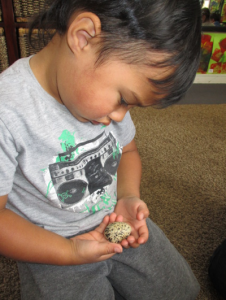
Caring for a dotterel egg
We researched with the children through online means, books, visits to the beach, with our DoC ranger, through our local paper ‘The Coastal News’, and by meeting the dotterel Care Group on the beach.
Adults learnt alongside the children. The growing knowledge was developed using strategies like story baskets, wall story-telling, drama, and incorporating key words (camouflage, predators, DoC, Kaitiaki, Tangaroa, Tāwhirimātea).
We supported this learning through a variety of media such as clay, plasticine, hot glue- gun creations, using natural resources, engaging detailed pencil sketches, using a light box for tracing, box constructions, block play, role play, and a sand tray story.
This work led to research about predators. We learnt how DoC traps rats, stoats and hedgehogs, and we purchased our own DoC200 predator trap – we have caught several rats – and pest pictures were added to the story wall display.
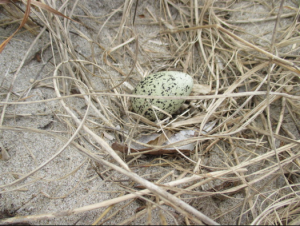
An egg camouflaged in the dune.
We also made a dotterel hide out of untreated timber, and camouflaged it with sand and shells. Our DoC ranger placed it close to the nests, and some of our whānau told us they had seen the chicks sheltering under it.
“I am amazed at how Megan articulated her knowledge of dotterels to friends of ours when on the beach recently. I am proud that Megan knew so much and was able to clearly teach others, that she remembered so much from last year when she was just two years old. She said this kindergarten rocks!” – Rachel, Megan’s mum.
What do we know about Dotterals? Children said…
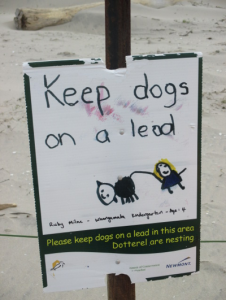
Children made signs and DoC erected them on the beach.
They live on the beach
They have eggs, three eggs
The dad has a dark orange chest
The mum has a light orange chest
They have white underpants (underparts)
They make a hole in the sand for their eggs
They make their nests in the dry sand
You aren’t allowed to go under the fence or you might hurt them
The waves wash them away
They lay three eggs at a time
They sit on their eggs to keep them warm
They don’t make nests in trees or rooves like our blackbird
They have a black beak
They are little and walk and run on the sand
They like to make their nests on the dry sand
They eat sandhoppers, we found some sandhoppers today
Maybe they eat worms or crabs
Oyster catchers live on the beach too.
“Through feedback from whānau, children’s responses and conversations, and through our daily and recorded observations we were able to determine the valuable teaching and learning that occurred. This process empowered children to teach others” – Jenny Elwin, Head Teacher.

Artwork about dotterals.